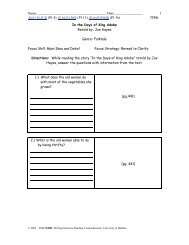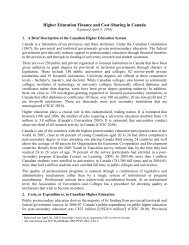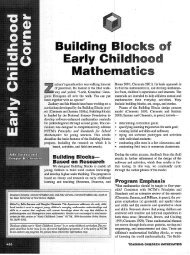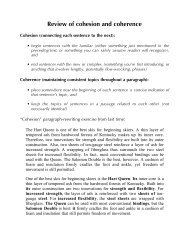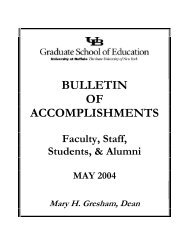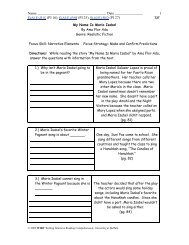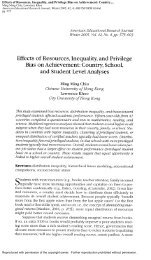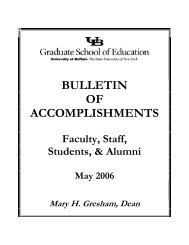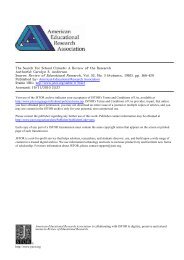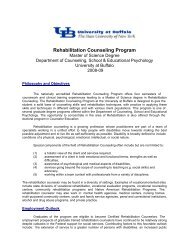Syllabication
Syllabication
Syllabication
You also want an ePaper? Increase the reach of your titles
YUMPU automatically turns print PDFs into web optimized ePapers that Google loves.
<strong>Syllabication</strong>
<strong>Syllabication</strong>The ability to segment words into syllables (a letter or group of letters that forms apronunciation unit), which is a form of phonemic awareness that can be useful whenencountering unknown words.A syllable ending in a vowel (CV).A syllable ending with a consonant (CVC).Open SyllableClosed Syllable
Word-Attack Generalizations for <strong>Syllabication</strong><strong>Syllabication</strong> Rule 1:<strong>Syllabication</strong> Rule 2:<strong>Syllabication</strong> Rule 3:<strong>Syllabication</strong> Rule 4:<strong>Syllabication</strong> Rule 5:<strong>Syllabication</strong> Rule 6:<strong>Syllabication</strong> Rule 7:<strong>Syllabication</strong> Rule 8:A word has as many syllables as vowel sounds; remember afinal e is usually silent.Whenever two consonants represent one sound (digraphsth, ch, sh, ph, ck) they stay together in syllabicating.When r follows a vowel, it is attached to the vowel insyllabizing.A compound word is made up of two or more smallerwords. Syllable divisions occur between the words(birth/day, mail/man) and at other places as needed(bas/ket/ball).The common word beginnings (ad-, al-, com-, can-, de-,dis-, en-, ex-, in-, im-, per-, and un-) form the first syllableof the word.Word endings (-cal, -ed, -ful, -ish, -ing, -ment, -ness, -tive,-sive, -ture, -tion, -sion, -ty, -ly, -fy, -ity, -less) usually aredivided from the rest of the word forming the final syllable.(Exceptions: the ed forms a new syllable only if the verbroot ends in d or t).When le ends a word it forms a syllable with the precedingconsonant.When two consonants or a consonant and a blend comebetween two vowels, the syllable division is between theconsonants or the consonant and blend.Lesiak, J., & Bradley-Johnson, S. (1983). Reading assessment for placement andprogramming. Springfield, Illinois: Charles C Thomas Publisher.
Separated-Syllables ReadWrite words on the chalkboard syllable by syllable, leaving enough space between theword parts for students to see syllable divisions. Ask students to use their knowledge ofcommon syllable spelling patterns (e.g., closed syllables, open syllables, consonant + -le)to read each word. Model blending as necessary by discussing syllable generalizations.When there’s a question about a syllable’s pronunciation be sure to have students explainwhy they pronounced it as they did. It is critical that students be able to verbalize all sixsyllable-spelling patterns. When they’ve read each syllable in a word, have students readthe word at a natural pace (Gillingham and Stillman, 1997).fan tas tic fa ble ab sent pump kin ad ven ture croc o dileRelated-Syllables ReadWrite on the chalkboard a series of related open and closed syllables such as re, rem, em.Have students use their knowledge of open and closed syllables to read each.Alternative: Create syllable lists using all prefixes, all suffixes, all consonant + -le, orsome other grouping.re rem em lo lom omfi fim im bo bot otMultisyllabic Words ManipulationDivide words you’ve selected from upcoming reading selections into syllables. Writeeach syllable on a note card. Display the syllables that make up one of the words injumbled order (e.g., tas fan tic). Have students arrange the syllables to form the word.When necessary, discuss the pronunciation and spelling generalizations of any confusingsyllables.Syllable ScoopOn a reproducible master, write 20 multisyllabic words from an upcoming story. Havestudents work with a partner to draw an arc, or to scoop with their finger, under eachsyllable as they read each word aloud. Then have them code each syllable by type (e.g.,draw a macron over all open syllables with long vowel sounds, circle all the prefixes).Alternative: Have students code a specific type of syllable- circle all consonant + lesyllables or underline all closed syllables- and then read the words. Visually identifyingthe common syllable-spelling pattern makes reading the entire word easier.
Stomping, Clapping, Tapping, and Snapping SoundsPurpose:Helping children hear syllables in words enables them to segment sounds. Thisknowledge can be used in myriad ways to improve writing/spelling, increase awarenessof letter combinations used to produce speech sounds, and apply knowledge of onsets andrimes. All these skills and more enable students to sound out words in print moreeffectively. For ages, teachers have found success in helping children hear syllables byclapping them out when reading nursery rhymes, such as “Mar-y had a lit-tle lamb, lit-tle,lamb…”Materials:We prefer to use rhyming poetry, songs, chants, or raps for these syllabication activities.Use an enlarged version produced for an overhead projector, a big book version, orsimply rewrite the text on large chart paper using a colored ink marker.Procedure:First, model read the enlarged text aloud in a normal cadence for your students. Rereadthe selection at a normal cadence, inviting students to join in as they wish. Next, explainthat you will reread the selection, but this time you will clap (or snap, or stomp, and soon) the syllables in the words. (Note: If you have not already explained the concept ofsyllables, you will need to do so at this point.) Finally, invite students to clap (or makewhatever gesture or sound that you have chosen) as you reread the passage.Reutzel, D.R., & Cooter, R.B. (2003). Strategies for reading assessment and instruction:Helping every child succeed. Columbus, Ohio: Merrill Prentice Hall.
Reviewing syllabication rules 1 through 5Directions:Read the rules. Write each word, dividing it into syllables. Then write the number of therule that you used to help you.Rules:1. A one-syllable word is never divided.2. Divide a compound word between the words that make up the compoundword.3. When a word has a suffix with a vowel sound in it, divide the word betweenthe base word and the suffix.4. When a word has a prefix, divide the word between the prefix and the baseword.5. When two or more consonants come between two vowels in a word, the wordis usually divided between the first two consonants.1. airplane ______________________ 13. quickly __________________2. surprise ______________________ 14. hungry __________________3. homeless ______________________ 15. hardness __________________4. balloon ______________________ 16. displease __________________5. smallest ______________________ 17. slowly __________________6. monkey ______________________ 18. safe __________________7. donkey ______________________ 19. curtain __________________8. helping ______________________ 20. harmful __________________9. outdoors ______________________ 21. backyard__________________10. sudden ______________________ 22. churches __________________11. later ______________________ 23. railroad __________________12. refresh ______________________ 24. circus __________________
Small-Group ActivityPreparation for the Bunny Rabbit Race:Choose as many colors of construction paper as you have children in your smallgroup. Cut 10 circles out of each color. Arrange each set of circles in a straightline next to each other on a table or floor. This will be the rabbit race track. Placea bunny cutout on top of the first circle of each color, and place a string or pieceof yarn straight across between the ninth and tenth circles of each color. Thestring is the finish line.Copy and cup up picture cards for small group, mix up, and place face down infront of teacher at table or on floor.Activity:Explain to the children that each of them will be a bunny who is running a race.They will take turns drawing a card from the pile. Each child will say the wordon the picture and then figure out how many syllables are in the word. The childwill then move his or her bunny forward one hop for each syllable in the word.The first bunny to cross the finish line at the end wins. You can repeat this gameas often as time and the children’s attention permits.If a child is having difficulty determining the number of syllables in words, youcan clap with the child as he or she says the word. You may also wish to say theword for the child, pausing slightly between each syllable as a hint for him or herto clap. You might practice putting up a finger each time a syllable is said in aword; then at the end of the word the child can count the number of fingers thatare up to determine the number of syllables.
Informal Assessments of <strong>Syllabication</strong>Speed DrillsAdvanced Word and Sentence StructureSyllables in words containing vowel digraphs.
Speed DrillsThese quick-paced, timed drills are fun. One drill contains 20 common syllables inrandom order. The other contains words with a specific syllable-spelling pattern(consonant + le). Before timing students, give them a chance to practice reading thesyllables or words on the drill. Then, give them one minute to read as many syllables orwords on the drill. This must be done one-on-one with each student. I suggest selectingfive students on each day to test. On a copy of the drill, mark the syllables or words thestudents mispronounce. Have student’s count the number of syllables or words readcorrectly and mark this on a progress. Students find it highly motivating to track theirown progress.
Sample Syllable Speed Drilling un ture ex dis com un im ter menter der ing dis un ver er ble ble tionter num ment ver ing bout der ex er pletion ble er ple ple re dis num re estre ment bout re ble der ing com un verver ture un ble er em bout tion ing tureex est ter im num ex ter re fi combout dis com tion est tion ture ver dis excom im est num ter ment ment fi der boutple fi der fi ture fi est ple num im
Sample Consonant + le Word Speed DrillBubble circle giggle pebble steeple wiggle fable middle sampleBattle crinkle handle little sparkle puddle bottle steeple rattleangle fable purple shingle stubble uncle angle marble needlebridle cattle fizzle middle rattle wrinkle title apple uncleapple eagle noble simple struggle title cattle gentle pebbleankle fiddle kettle puzzle puddle saddle eagle rumble vehicledouble maple jungle rumble temple vehicle circle giggle purplebottle dazzle kindle mantle sprinkle bubble fiddle tumble junglebugle marble sample single tumble double bundle maple littlebundle gentle muzzle needle settle battle handle kettle bridle
Elementary School-Advanced Word & Sentence StructureGoal: The student is able to syllabicate words ending in le and ed by using the rules ofsyllabication which apply these endings.Objectives:The student is able to identify that in words ending with a consonant plus le thesyllable division occurs before that consonant (handle- han/dle).The student is able to identify that in words ending in ckle the le stands alone as afinal syllable (pick/le).The student is able to identify that in a word ending in ted or ded the ed is aseparate syllable.
Elementary School: Advanced Word & Sentence Structure- Goal 2Pre-TestDirections: Read each example. Choose the correct answer.1. Which word is corectly divided? 6. Which word is correctly divided?A. Lit/tle A. roo/tedB. Li/ttle B. ro/otedC. Litt/le C. root/ed2. Which word is correctly divided? 7. Which word is correctly divided?A. tic/kle A. marb/leB. tick/le B. mar/bleC. ti/ckl C. m/arble3. Which word is correctly divided? 8. Which word is correctly divided?A. bai/ted A. cra/ckleB. bait/ed B. cr/ackleC. ba/ited C. crack/le4. Which word is correctly divided? 9. Which word is correctly divided?A. a/pple A. want/edB. app/le B. wa/ntedC. ap/ple C. wan/ted5. Which word is correctly divided?A. buck/leB. bu/ckleC. buc/kle*** Post-Test same questions, but in different order.
Elementary School-Advanced Word & Sentence Structure Goal 2Question Objective AnswerNumber1 2.01 A2 2.02 B3 2.03 B4 2.01 C5 2.02 A6 2.03 C7 2.01 B8 2.02 C9 2.03 ADiagnostic Assessment Key
Syllables in words containing vowel digraphsDirections:Read each word. On the first line, write the number of vowels you see. Say eachword. On the second line, write the number of vowel sounds you hear. On the thirdline write the number of syllables in the word.VowelVowels Sounds NumberYou You ofSee Hear Syllablesautumnshookbreadweighbroomsweaterbookcaseschoolreindeerspoolseizefeatherbedspreadweightedwoodpeckerlaundrywoodpileinsteadneighborlynaughtyheadlineshookp
Filename:reading_syllabicationDirectory:C:\Documents and Settings\helpdesk\My Documents\CookTemplate:C:\Documents and Settings\helpdesk\ApplicationData\Microsoft\Templates\Normal.dotTitle:PhonicsSubject:Author:Bill BiniszkiewiczKeywords:Comments:Creation Date:3/22/2003 4:40 PMChange Number: 2Last Saved On: 3/22/2003 4:40 PMLast Saved By: Public ComputingTotal Editing Time: 0 MinutesLast Printed On: 4/6/2003 9:58 AMAs of Last Complete PrintingNumber of Pages: 18Number of Words: 2,631 (approx.)Number of Characters: 14,999 (approx.)



